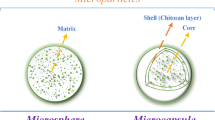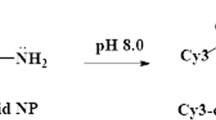Abstract
Stereocomplexed nano- and microparticles composed of a mixture of enantiomeric polylactides (PDLA and PLLA) are often used in biomedical applications. Here, we propose their additional application as a microcarrier for enhancing agricultural production for the first time. For this purpose, the synthesis of enantiomeric polylactides was performed in bulk by employing the ring-opening polymerization method, and the prepared macromolecules were subsequently used for the gram-scale preparation of quercetin-loaded stereocomplexed microparticles by spontaneous precipitation in an organic solvent. This facile approach leads to particles with porous structures and sizes ranging from 2 to 6 μm. Subsequently, the cumulative release of quercetin (Q) was compared in water and sodium chloride solution. Finally, the plant fertilization activity of the obtained Q-loaded microparticles was tested in Pisum sativum L. (green peas). Our strategy provides a novel route for the enhancement of plant growth by biocompatible and biodegradable carriers loaded with flavonoids.








Similar content being viewed by others
Data Availability
The data can available on request.
References
Ye L, Zhao X, Bao E et al (2020) Bio-organic fertilizer with reduced rates of chemical fertilization improves soil fertility and enhances tomato yield and quality. Sci Rep 10:1–11. https://doi.org/10.1038/s41598-019-56954-2
Fujiwara M, Shoji S, Murakami Y (2019) Controlled release of phosphate fertilizer using silica microcapsules. Chem Lett 48:658–661. https://doi.org/10.1246/cl.190192
Panche AN, Diwan AD, Chandra SR (2016) Flavonoids: an overview. J Nutr Sci 5:1–15. https://doi.org/10.1017/jns.2016.41
Singh P, Arif Y, Bajguz A, Hayat S (2021) The role of quercetin in plants. Plant Physiol Biochem 166:10–19. https://doi.org/10.1016/j.plaphy.2021.05.023
Campión J, Milagro FI, Martínez JA (2009) Individuality and epigenetics in obesity. Obes Rev 10:383–392. https://doi.org/10.1111/j.1467-789X.2009.00595.x
Chaaban H, Ioannou I, Paris C et al (2017) The photostability of flavanones, flavonols and flavones and evolution of their antioxidant activity. J Photochem Photobiol A 336:131–139. https://doi.org/10.1016/j.jphotochem.2016.12.027
Gao L, Liu G, Wang X et al (2011) Preparation of a chemically stable quercetin formulation using nanosuspension technology. Int J Pharm 404:231–237. https://doi.org/10.1016/j.ijpharm.2010.11.009
Bakowska-Barczak AM, Kolodziejczyk PP (2011) Black currant polyphenols: their storage stability and microencapsulation. Ind Crops Prod 34:1301–1309. https://doi.org/10.1016/j.indcrop.2010.10.002
Chang-Bravo L, López-Córdoba A, Martino M (2014) Biopolymeric matrices made of carrageenan and corn starch for the antioxidant extracts delivery of Cuban red propolis and yerba mate. React Funct Polym 85:11–19. https://doi.org/10.1016/j.reactfunctpolym.2014.09.025
Wang W, Sun C, Mao L et al (2016) The biological activities, chemical stability, metabolism and delivery systems of quercetin: a review. Trends Food Sci Technol 56:21–38. https://doi.org/10.1016/j.tifs.2016.07.004
Michalski A, Makowski T, Biedroń T et al (2016) Controlling polylactide stereocomplex (sc-PLA) self-assembly: from microspheres to nanoparticles. Polymer (Guildf) 90:242–248. https://doi.org/10.1016/j.polymer.2016.03.049
Tsuji H (2016) Poly(lactic acid) stereocomplexes: a decade of progress. Adv Drug Deliv Rev 107:97–135. https://doi.org/10.1016/j.addr.2016.04.017
Brzeziński M, Kost B, Wedepohl S et al (2019) Stereocomplexed PLA microspheres: control over morphology, drug encapsulation and anticancer activity. Colloids Surf B. https://doi.org/10.1016/j.colsurfb.2019.110544
Wojtczak E, Gadzinowski M, Makowski T et al (2018) Encapsulation of hydrophobic vitamins by polylactide stereocomplexation and their release study. Polym Int 67:1523–1534. https://doi.org/10.1002/pi.5674
Boi S, Dellacasa E, Bianchini P et al (2019) Encapsulated functionalized stereocomplex PLA particles: an effective system to support mucolytic enzymes. Colloids Surf B 179:190–198. https://doi.org/10.1016/j.colsurfb.2019.03.071
de Araújo FF, de Paulo Farias D, Neri-Numa IA, Pastore GM (2021) Polyphenols and their applications: an approach in food chemistry and innovation potential. Food Chem 338:127535. https://doi.org/10.1016/j.foodchem.2020.127535
Thommes M, Kaneko K, Neimark AV et al (2015) Physisorption of gases, with special reference to the evaluation of surface area and pore size distribution (IUPAC Technical Report). Pure Appl Chem 87:1051–1069. https://doi.org/10.1515/pac-2014-1117
Barrs H (1968) Determination of water deficits in plant tissues. In: Water Deficits and Plant Growth. pp 235–368
Singleton VL, Rossi JAJ (1965) Colorimetry to total phenolics with phosphomolybdic acid reagents. Am J Enol Vinic 16:144–158
Lichtenthaler HK, Buschmann C (2001) Chlorophylls and carotenoids: measurement and characterization by UV-VIS spectroscopy. In: Wrolstad RE, Acree TE, An H, Decker EA, Penner MH, Reid DS, Schwartz SJ, Shoemaker CF, Sporns P (eds) Current protocols in food analytical chemistry. John Wiley & Sons, Inc., New York, NY, F4.3.1–F4.3.8
Bouriche S, Alonso-García A, Cárceles-Rodríguez CM et al (2021) An in vivo pharmacokinetic study of metformin microparticles as an oral sustained release formulation in rabbits. BMC Vet Res 17:1–11. https://doi.org/10.1186/s12917-021-03016-3
Pool H, Quintanar D, de Figueroa J et al (2012) Antioxidant effects of quercetin and catechin encapsulated into PLGA nanoparticles. J Nanomater 2012:1–12. https://doi.org/10.1155/2012/145380
Dall’Acqua S, Miolo G, Innocenti G, Caffieri S (2012) The photodegradation of quercetin: relation to oxidation. Molecules 17:8898–8907. https://doi.org/10.3390/molecules17088898
Ramešová Å, Sokolová R, Degano I et al (2012) On the stability of the bioactive flavonoids quercetin and luteolin under oxygen-free conditions. Anal Bioanal Chem 402:975–982. https://doi.org/10.1007/s00216-011-5504-3
Wu TH, Yen FL, Lin LT et al (2008) Preparation, physicochemical characterization, and antioxidant effects of quercetin nanoparticles. Int J Pharm 346:160–168. https://doi.org/10.1016/j.ijpharm.2007.06.036
Manisekaran A, Grysan P, Duez B et al (2022) Solvents drive self-assembly mechanisms and inherent properties of Kraft lignin nanoparticles (< 50 nm). J Colloid Interface Sci 626:178–192. https://doi.org/10.1016/j.jcis.2022.06.089
Venkatraman RK, Baiz CR (2020) Ultrafast dynamics at the lipid–water interface: DMSO Modulates H-bond lifetimes. Langmuir 36:6502–6511. https://doi.org/10.1021/acs.langmuir.0c00870
De La Torre C, Casanova I, Acosta G et al (2015) Gated mesoporous silica nanoparticles using a double-role circular peptide for the controlled and target-preferential release of doxorubicin in CXCR4-expresing lymphoma cells. Adv Funct Mater 25:687–695. https://doi.org/10.1002/adfm.201403822
Kobylińska A (2017) Exogenous quercetin as a proliferation atimulator in Tobacco by-2 cells. J Elem 22:245–258. https://doi.org/10.5601/jelem.2016.21.1.1097
Caliskan O, Radusiene J, Temizel KE et al (2017) The effects of salt and drought stress on phenolic accumulation in greenhouse-grown Hypericum pruinatum. Ital J Agron 12:271–275. https://doi.org/10.4081/ija.2017.918
Parvin K, Hasanuzzaman M, Borhannuddin Bhuyan MHM et al (2019) Quercetin mediated salt tolerance in tomato through the enhancement of plant antioxidant defense and glyoxalase systems. Plants 8:1–20. https://doi.org/10.3390/plants8080247
Martinez V, Nieves-Cordones M, Lopez-Delacalle M et al (2018) Tolerance to stress combination in tomato plants: new insights in the protective role of melatonin. Molecules 23:535. https://doi.org/10.3390/molecules23030535
Zhao C, Zhang H, Song C et al (2020) Mechanisms of plant responses and adaptation to soil salinity. Innovation 1:100017. https://doi.org/10.1016/j.xinn.2020.100017
Przybysz A, Gawro A, Gajc-Wolska J (2014) Biological mode of action of a nitrophenolates-based biostimulant: case study. Front Plant Sci. https://doi.org/10.3389/fpls.2014.00713
Kalaji HM, Jajoo A, Oukarroum A et al (2016) Chlorophyll a fluorescence as a tool to monitor physiological status of plants under abiotic stress conditions. Acta Physiol Plant. https://doi.org/10.1007/s11738-016-2113-y
Sharma A, Kumar V, Shahzad B et al (2020) Photosynthetic response of plants under different abiotic stresses: a review. J Plant Growth Regul 39:509–531. https://doi.org/10.1007/s00344-019-10018-x
Ma Y, Balamurugan S, Yuan W et al (2018) Quercetin potentiates the concurrent hyper-accumulation of cellular biomass and lipids in Chlorella vulgaris. Bioresour Technol 269:434–442. https://doi.org/10.1016/j.biortech.2018.07.151
Acknowledgements
The measurements of adsorption–desorption properties of obtained microparticles have been done on the apparatus ASAP 2020 Plus (Micrometrics) purchased under the Regional Operational Program for the Lodz Region, RPLD.01.01.00-10-0008/18. Purchase of the Avance Neo 400 NMR spectrometer, used to obtain results included in this publication, was supported by the founds from the EU Regional Operational Program of the Lodz Region, RPLD.01.01.00-10-0008/18.
Author information
Authors and Affiliations
Contributions
AK: The plant fertilization experiments, conceptualization, methodology, writing, reviewing and editing; KC: Polymer synthesis; BK: Conceptualization, MPs characterization, polymer synthesis, writing; IBK: Material characterization, writing; MB: Conceptualization, methodology, MPs preparation, writing, reviewing and editing.
Corresponding authors
Ethics declarations
Conflict of interest
The author declares that they have no competing interests.
Human and Animal Rights and Informed Consent
This article does not contain any studies with human participants or animals performed by the author.
Additional information
Publisher’s Note
Springer Nature remains neutral with regard to jurisdictional claims in published maps and institutional affiliations.
Supplementary Information
Below is the link to the electronic supplementary material.
Rights and permissions
Springer Nature or its licensor (e.g. a society or other partner) holds exclusive rights to this article under a publishing agreement with the author(s) or other rightsholder(s); author self-archiving of the accepted manuscript version of this article is solely governed by the terms of such publishing agreement and applicable law.
About this article
Cite this article
Kobylińska, A., Kost, B., Cichoń, K. et al. Stereocomplexed Microparticles as Quercetin Carriers for Improving Plant Growth During Salinity Stress. J Polym Environ 31, 1209–1220 (2023). https://doi.org/10.1007/s10924-022-02678-w
Accepted:
Published:
Issue Date:
DOI: https://doi.org/10.1007/s10924-022-02678-w




